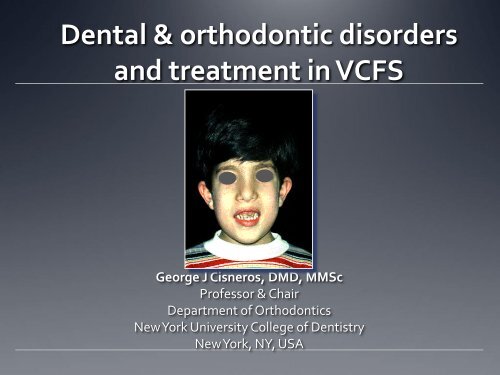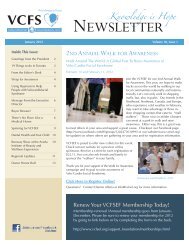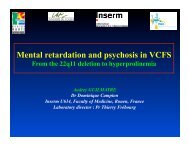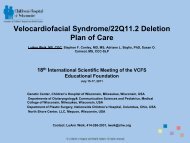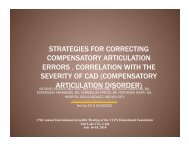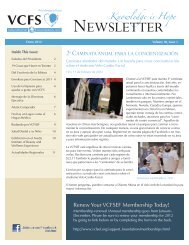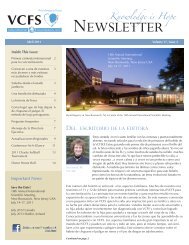Dental and orthodontic disorders and treatment in VCFS
Dental and orthodontic disorders and treatment in VCFS
Dental and orthodontic disorders and treatment in VCFS
Create successful ePaper yourself
Turn your PDF publications into a flip-book with our unique Google optimized e-Paper software.
<strong>Dental</strong> & <strong>orthodontic</strong> <strong>disorders</strong><br />
<strong>and</strong> <strong>treatment</strong> <strong>in</strong> <strong>VCFS</strong><br />
George J Cisneros, DMD, MMSc<br />
Professor & Chair<br />
Department of Orthodontics<br />
New York University College of Dentistry<br />
New York, NY, USA
Overview<br />
• <strong>Dental</strong> – Oral Health<br />
• Orthodontic<br />
• Related Studies
<strong>Dental</strong> - Oral Health Concerns<br />
• Hypodontia<br />
• Small Teeth<br />
• Hypoplasia<br />
• Poorly Developed Teeth<br />
• Saliva<br />
• Quality & Quantity<br />
• Metabolic Factors<br />
• Caries<br />
•
Orthodontic Issues<br />
• Hypodontia<br />
• Small Teeth<br />
• Delayed Tooth Eruption<br />
• Anodontia<br />
• Miss<strong>in</strong>g Teeth<br />
• Malocclusion<br />
•
Related Studies<br />
• Craniofacial Morphology <strong>in</strong> the Velo-cardio-facial<br />
Syndrome<br />
• Arvystas <strong>and</strong> Shpr<strong>in</strong>tzen,1984<br />
• A Comparison of Two Syndromes with the Rob<strong>in</strong> Sequence<br />
• Gl<strong>and</strong>er <strong>and</strong> Cisneros,'91<br />
• Craniofacial Morphology <strong>and</strong> Velopharyngeal Physiology<br />
<strong>in</strong> Four Syndromes of Cleft<strong>in</strong>g<br />
• Gold<strong>in</strong>g-Kushner,'91<br />
• <strong>Dental</strong> Characteristics Associated with <strong>VCFS</strong><br />
• Lisa A. Lehky,’96
Craniofacial Morphology <strong>in</strong> the<br />
Velo-cardio-facial Syndrome<br />
Arvystas <strong>and</strong> Shpr<strong>in</strong>tzen,1984<br />
• Lateral cephalographs<br />
• 13 patients<br />
• Cranial base angle<br />
• normal literature - 129°<br />
• VCF - 137°
A Comparison of Two Syndromes with<br />
the Rob<strong>in</strong> Sequence<br />
Gl<strong>and</strong>er <strong>and</strong> Cisneros,'91<br />
• Velo-cardio-facial<br />
• non-Rob<strong>in</strong> (N=18) & Rob<strong>in</strong> (N=11)<br />
• Stickler<br />
• non-Rob<strong>in</strong> (N=11) & Rob<strong>in</strong> (N=9)<br />
• Cephalometric Analysis<br />
• 50 variables<br />
• Hard & soft tissue
Cephalometric Analysis<br />
Skeletal<br />
Soft Tissue
A Comparison of Two Syndromes with<br />
the Rob<strong>in</strong> Sequence<br />
Results<br />
• No difference between VCF (non-Rob<strong>in</strong>) <strong>and</strong> VCF<br />
(Rob<strong>in</strong>)<br />
• Rob<strong>in</strong> symptoms – neuromuscular<br />
• not due skeletal / soft tissue morphology<br />
• Morphological differences were noted<br />
• Stickler (non-Rob<strong>in</strong>) v. Stickler (Rob<strong>in</strong>)
Craniofacial Morphology <strong>and</strong> Velopharyngeal<br />
Physiology <strong>in</strong> Four Syndromes of Cleft<strong>in</strong>g<br />
Gold<strong>in</strong>g-Kushner,'91<br />
• Cephalometrics<br />
• Speech<br />
• Videofluoroscopy<br />
• Nasopharyngoscopy<br />
• Syndromes-<br />
• Velo-cardio-facial<br />
• Stickler<br />
• Treacher-Coll<strong>in</strong>s<br />
• Van der Woude
Craniofacial Morphology <strong>and</strong> Velopharyngeal<br />
Physiology <strong>in</strong> Four Syndromes of Cleft<strong>in</strong>g<br />
• In VCF<br />
• Flat cranial base<br />
• <strong>in</strong>creased pharyngeal depth<br />
• Th<strong>in</strong> pharyngeal soft tissue, th<strong>in</strong>/short soft<br />
palate<br />
• suggest<strong>in</strong>g muscle deficiency<br />
• Prevalence <strong>and</strong> severity of VPI <strong>in</strong>creased
Velo-cardio-facial Syndrome<br />
• Platybasia (cranial base)<br />
• Low sella<br />
• Short posterior cranial base<br />
• Normal anterior cranial base<br />
• Convex facial profile<br />
• Hyperdivergent jaw pattern<br />
• Short m<strong>and</strong>ibular body<br />
• Normal maxilla<br />
• Large/wide pharyngeal space
Velo-cardio-facial Syndrome
<strong>Dental</strong> Characteristics Associated with <strong>VCFS</strong><br />
Lehky,’96<br />
<strong>Dental</strong> characteristics associated<br />
with <strong>VCFS</strong> patients compared to<br />
controls <strong>and</strong> normative data
Distribution of congenitally<br />
miss<strong>in</strong>g m<strong>and</strong>ibular teeth
Distribution of congenitally<br />
miss<strong>in</strong>g maxillary teeth
Distribution of congenitally<br />
miss<strong>in</strong>g teeth by arch
Distribution of congenitally<br />
miss<strong>in</strong>g teeth
<strong>VCFS</strong><br />
Control group<br />
Previous data - general population<br />
• Higher prevalence of miss<strong>in</strong>g m<strong>and</strong>ibular teeth<br />
• Pattern of miss<strong>in</strong>g teeth differed<br />
• Delayed calcification - m<strong>and</strong>ibular posterior teeth<br />
• All permanent teeth - smaller mesial-distal width


